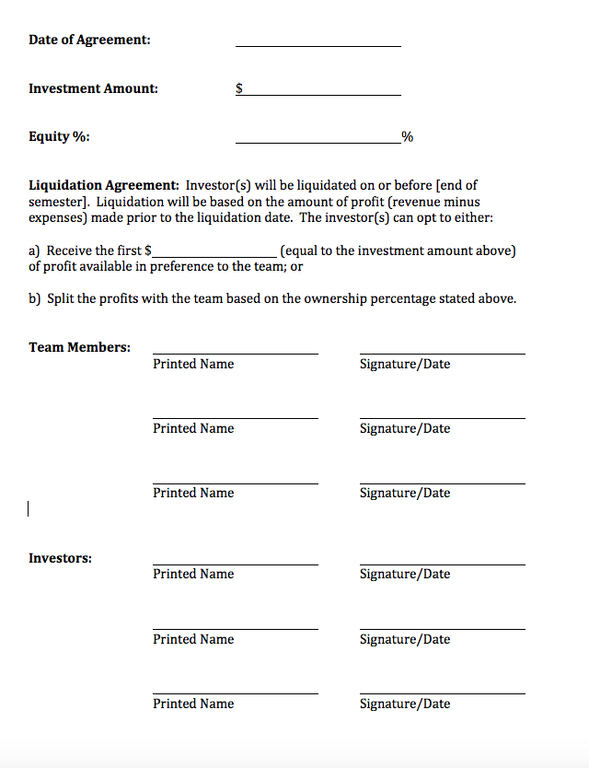'Tommie Tank' Helps Students Learn to Finance Ventures

The course improved students’ confidence, helped build a student-alumni community, and enhanced students’ connection to what raising money actually means.
Two-and-a-half years ago, we set out to design our entrepreneurial finance course at the University of St. Thomas around an experiential project. Our idea was straightforward: we wanted students to actually raise money for a business concept and then execute on it; our expectation was that students would better learn everything that we teach in e-finance, from pro formas to liquidation preference, if they experienced it. The project we developed and implemented has had even better outcomes than we anticipated and we have continued to refine it over subsequent semesters.
The 'Tommie Tank'
Our big questions were how to create something meaningful and manageable in a single semester, and how to make it sustainable semester to semester. We decided to experiment in Spring 2015 with a relatively low-risk project that, instead of using university funding, would bring alumni of our program into class as investors. We called it “The Tommie Tank” and the basic concept was as follows:
- Early in the semester, student teams would have 60 seconds to pitch a business concept to a panel of investors. The investors would be alumni business owners who graduated in the past 10-12 years and were familiar with our program. Teams could ask for an investment between $50 and $200 in exchange for a share in profits made and were expected to make a case for why they could provide a 50% return on the investment.
- Like the Shark Tank television show, investors would ask questions and decide whether to invest their own money in the business (if students did not raise money from the panel, they would be on their own to get an investment elsewhere).
- Students would then be required to execute on their concept and exit the investor by the end of the semester. To limit the potential downside for investors, they would be able to choose to either receive their investment back or convert to the agreed percentage of profits at exit. All of this would be spelled out in a basic term sheet (see Appendix 1).
Impact on Students
While our entrepreneurial finance course had previously been highly regarded, this project brought a new level of energy and understanding to the class. In terms of learning outcomes, we have observed a significant impact on students’ confidence, the building of student-alumni community, and students’ connection to what raising money actually means. While these observations were not scientifically measured, they do come from the instructor’s 10 years of experience teaching entrepreneurial finance to undergraduates prior to implementing the Tommie Tank project.
Confidence:
- Students’ comfort level with numbers noticeably increased, including their comfort level with building out and analyzing pro formas.
- Students have demonstrated a better ability to build a financial case around how valuation and equity percent relate to potential return.
- Students learn how important it is to know their numbers and how to respond to tough questions about them (i.e., how their business will make money and generate a return).
- Students experience and respond to the pressure and accountability that comes with having someone who believes in them put money at stake.
Community:
- The project brings students together around an experience that is outside their comfort zones, and everyone supports one another in the process.
- It provides a platform to create bonds between students and alumni mentors and to strengthen alumni ties to our program. One alumni investor has even created a “recruiting fund” out of which he made his Tommie Tank investments this fall, viewing it as a way for him to identify and hire our top students.
Connection:
- Students are very focused on the fact that the outcome of the project impacts more than themselves, and are determined not to let investors down. In fact, one group whose business wasn’t working decided late in the semester to hire themselves out as consultants to neighborhood businesses just so they could provide a return to their investors.
- Students come to realize that getting an investment means so much more than just getting money. Bringing on an investor is the start of a relationship, so finding the right investor is key.
The impact is demonstrated in the following quotes from students:
- "It was empowering to know that the investors invested in me and my teammate and not necessarily our idea. It was such a rewarding experience being able to raise money, generate revenue, and give a return on investment that our investors were happy with in less than two months."
- “I grew so much this semester from the Tommie Tank. It was an experience I needed to have.”
- “This is by far the best class I have taken. The ability to pitch your idea, execute, learn from investors, learn how to value your company and how to manage your investment was invaluable.”
- “One of the most valuable things I learned from the Tommie Tank was learning to deal with investors… how to meet with your investor, how to effectively communicate, and the stress of trying to return an investment while running a business.”
- “I didn’t expect to be able to come in here and ask for a $200 investment for a business we created 14 days ago. I’m proud we did it.”
- “If we did all of this in just a week and a half, just imagine what we can do in three or four months.”
- “It gives you more of a drive. We have somebody holding us accountable.”
Alumni Reaction
Just as important, the reaction from our alumni “Sharks” has been extremely positive. All of them have found it to be a meaningful and fun way to connect with and mentor students, and all want to be invited back each semester. The quotes below illustrate their perception of the project:
- "I got involved with Tommie Tank because I believe that learning how to raise money and being accountable to investors is a very important lesson for young entrepreneurs. In business, nothing feels worse than losing money that others entrusted you with and nothing feels better than providing a return to those who had faith in you. It is a good lesson to learn early on a small scale, and Tommie Tank provides that."
- “Often I find the misconception that entrepreneurship means you don't have to answer to anyone, when in fact that is the complete opposite. Whether it's your investors, partners or clients, there are always people to answer to. Tommie Tank gives these aspiring entrepreneurs the opportunity to learn that first hand, by forcing them to answer to an investor.”
- “Not only does the Tommie Tank give me the opportunity to stay connected to my professors and classmates, but it also provides me with a way to share my experiences with the students and motivate them to pursue their dreams and passions.”
- “The greatest reward is seeing the students’ reaction when a shark believes in their idea and invests.”
- “The Tommie Tank is an exciting, high energy learning experience that connects young entrepreneurs and alumni. It forces students to take what they learned in the classroom and turn it into action; all while being held accountable by their team, classmates, professor and Shark. I wish that I had this opportunity when I was an undergrad in the St. Thomas business program.”
- “I think all of the judges agree when I say, ‘We wish we had this opportunity when we were students!’ My partner and I made the leap from full-time students to full-time entrepreneurs immediately, and while we were prepared in many regards, there were a lot of real-life situations we had never experienced. Asking for $ was one of them. Getting grilled on how much money we really needed and how we planned on using it was another.”
- “While the small 'investment opportunities' seem silly at first blush, the monetary exchange and expectations that come with it are very real.”
- “I started my first venture in college with very little money and the goal of doubling my initial investment within a short amount of time. Tommie Tank is structured the same way and proves to students that with a bit of ingenuity and several hours of figuring out how to make it work, they can make it happen.”
Numerical Results
In five semesters, we have had 48 teams pitch in the Tommie Tank. Six teams did not receive an investment and were required to secure money on their own.
As evidence of how students have responded to the challenge, here are the numerical results to date:
- A total of $3,580 has been invested in the 48 businesses (an average of $75 per business).
- The businesses have generated a total of $31,961 in revenue (an average of $665 per business).
- A total of $5,718 has been paid out to investors, for an average ROI of 60%. Forty-two of the 48 businesses returned at least the amount of the investment.
Refinements
While there are likely many ways to design this project successfully within a class -- in terms of when pitches are made, how much money can be raised, how long students have to execute, etc. -- we have learned several lessons from running the project and have made adjustments accordingly. For example:
- We moved the pitch for investment from the beginning of the semester to the middle of the semester, which allows us to more adequately cover topics related to deal structure beforehand. This gives students more time to prepare for the Tommie Tank and gain confidence in their concepts and numbers, and has resulted in a significant improvement in their ability to pitch and respond to questions.
- We brought the maximum limit for investments down from $200 to $150 and have learned to coach students to not ask for more money than they need. Several teams asked for $200 the first semester of the project and had a difficult time convincing investors they needed this much money and could execute well enough to generate a return.
- We now take time for instructor/team meetings 2-3 weeks before the Tommie Tank pitches, and additional meetings immediately following the pitches. Meetings before the Tommie Tank are used to walk through pro formas and how the “numbers story” should go, as well as what teams need to do in the next 2-3 weeks to make their pitches more compelling. Meetings following the Tommie Tank are used to discuss lessons learned from the pitches and next steps for execution.
- After the investment pitches, we now focus the course topics around the execution of Tommie Tank businesses. Originally, we went on to general course topics (like valuation, deal structure, etc.) with case studies, but both the instructor and students felt like the course was disjointed and that we “forgot about” the Tommie Tank projects. We use class time to hone in on the economic model of their business, cash management, and other financial-related issues, which more effectively ties the project to the course.
From these lessons, we have refined our own project to the following format/schedule:
- We spend the first half of the semester (6-7 weeks) learning the concepts that will go into the pitch -- pro formas, valuation, deal structure, and returns -- so that students understand how to speak to the numbers and negotiate with investors.
- Midway through the semester, students pitch in the Tommie Tank to raise money and then have the remainder of the semester (6-7 weeks) to execute.
- The semester culminates with the investors coming back in for final presentations. This is an excellent way to end the semester with high energy: it gives students a stage to brag about what they accomplished and investors a stage to share their observations about teams and their performance.
We have also learned to coach students toward certain types of projects to give them a better experience and greater opportunity to succeed:
- Products or services that can be sold face-to-face are much easier to execute than web sales or sales via retail stores given the pitfalls/time issues with both of those channels. Most often, this means sales on or around campus.
- Students are more successful choosing products/services with higher margins per sale than they are trying high-sales/low-margin strategies. Investors are more receptive to these types of concepts as well.
- Products/services that are unique generate more interest from investors than those that are simply easy to execute (such as selling t-shirts). In this aspect, students should understand that most investors are interested in more than just making money.
- Examples of projects that fit the above criteria and have been successful are: iPhone screen repair, boxes of assorted feminine products, graduation mugs, homemade all-natural sunscreen, autumn leaf clean-up, handmade Minnesota-themed jewelry, and weekly delivery of vegetables from a local farm to campus residents.
Legal Issues
We were given a waiver from the Minnesota Department of Commerce regarding securities registration due to the project’s educational purpose and the rules above that limit dollar amounts and downside risk for investors. We believe this is an important precedent for other programs that might wish to implement a similar project.
Future Application and Research
One area of future application is an adapted version of the project designed for more advanced students such as MBA’s. To challenge this group more, students could be given less structure – for instance, they might be asked to create their own term sheet for negotiation, to come up with their own method for valuing their business, etc. These aspects are strictly defined for undergraduates to reduce ambiguity.
It would also be useful to conduct more formal research around outcomes of this project from multiple classrooms and campuses. While we believe that our observations on outcomes are valid, we acknowledge that they are observations from one single setting and not necessarily representative.
A second area of research could include team composition. It is likely that team member skill sets impact outcomes for individual students, and it would be useful to understand this for optimizing the project.
Conclusion
We believe that the innovation in this project comes from the fact that it is easily replicated and sustainable: it can be implemented into an existing single-semester course without the need for funding. Because of this, any program in the country can easily experiment with this project to see its impact and how it might be tailored to best meet their needs.
Appendix 1 – Tommie Tank Term Sheet

Additional Search Terms: teaching entrepreneurship, resources for professors, resources for teaching, business schools, entrepreneurship schools, classroom exercises



